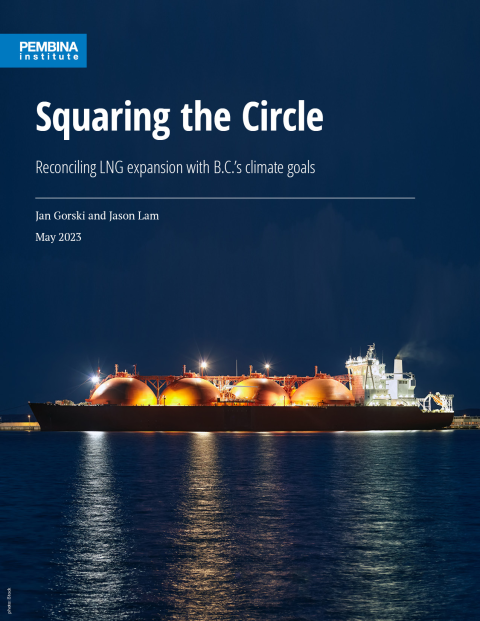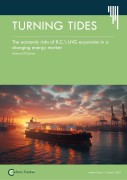British Columbia will soon have its first major liquefied natural gas (LNG) export terminal, with the anticipated completion of the first phase of the LNG Canada project in 2025. Woodfibre LNG is also on track to begin construction in 2023. In addition, four other export projects are proposed and awaiting decisions to proceed.
The production and export of LNG is an emissions intensive process. Emissions are generated in the upstream (where natural gas is produced), through the midstream (processing and transporting the gas by pipeline), and at the terminal (where it is liquefied and exported). As such, for LNG projects to fit within B.C.’s 2030 climate targets, the policies announced in the recent energy action framework are critical.
Without the framework, under currently implemented policy, our modelling shows that if LNG Canada Phase 1 and Woodfibre LNG — the only two projects on track to be built — proceed, emissions from B.C.’s oil and gas sector will be almost double the government’s 2030 sectoral target. If all four additional projects proceed, total emissions could reach more than three times the sectoral target.
To meet the 2030 oil and gas sector target, our modelling shows the vast majority of emissions reductions will need to come from extensive electrification of LNG terminals and in upstream natural gas production. However, this will put significant pressure on B.C.’s clean electricity grid. If only LNG Canada and Woodfibre LNG proceed, about 13 TWh of additional electricity will be required to electrify the terminal and upstream processes. This is 2.5 times greater than what is generated by B.C.’s Site C hydroelectric dam.
Thus, policies and initiatives announced in B.C.’s energy action framework are critical for the province to meet its 2030 oil and gas sector emissions target. The scale of proposed LNG development in B.C. presents a challenge for the province as it seeks to meet its climate targets due to the need to build large amounts of new electricity infrastructure to do so.
Global demand for fossil fuels, including LNG, is expected to decline in the years ahead, while demand for clean energy sources will grow. Both LNG and industrial sectors will require clean electricity and B.C. must carefully consider how to prioritize that electricity in a way that benefits future economic growth. Devoting large amounts of clean electricity to LNG could drive away investment in growing clean industries such as critical minerals mining and green hydrogen production. It could also impact available capacity for the electrification for other parts of B.C.’s economy such as transportation, and buildings.
The policies in the framework are critical to aligning B.C.’s climate targets with its economic goals and to position the province to benefit from opportunities in the new energy economy. The BC Hydro task force in particular is needed to provide these sectors with access to clean electricity and prioritize its use.
The BC Hydro task force faces the challenge of reconciling electricity needs across B.C.’s clean energy economy. We recommend that:
- The BC Hydro task force start planning new clean electricity generation and transmission infrastructure to decarbonize key economic sectors and meet 2030 climate targets.
- The BC Hydro task force prioritize electricity use for projects in economic sectors which are expected to see long-term growth on the global path to net-zero, including new clean energy projects.
- The B.C. government account for the availability of clean electricity when evaluating new LNG projects and their 2030 net-zero plans.
- BC Hydro prioritize Indigenous partnerships and economic opportunities for Indigenous communities and governments in new electricity projects.






